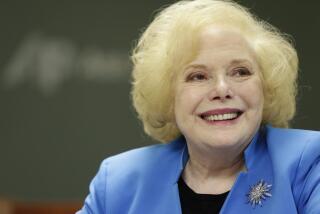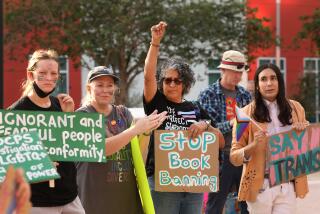Reenactments No Substitute for Real Life
If ever an event symbolized the congealing of news and entertainment, itâs the civil trial of O.J. Simpson.
If disoriented, you have cause: The trial is getting sober daily coverage from E! Entertainment Television, a cable network âdedicated to the world of entertainment,â while mainstream TV news coverage is as theatrical as ever.
That includes last weekâs whoop-de-do about a teenage court intern who reportedly accused Simpson of so-called improprieties ranging from âsexual harassmentâ to asking her out socially to undressing her with his eyes to ogling her butt to just making her feel icky in general. Simpson issued a denial, but the sheer weight of the coverage gave the story a false credibility, implying that it had to be true because the source was blond and pretty, just like you-know-who.
By weekâs end, Simpsonâs reported accuser was said to have given up her court internship, but her future surely includes some tabloid gigs, a Larry King shot and probably a book too. Well, Iâll sure buy it.
Enough of that, and on to the higher road at E! and its nightly hour recaps of the civil trial, featuring professional actors in reenactments of the previous dayâs testimony, drawn word-for-word from official transcripts.
Why reenactments? With cameras unfortunately banned from the courtroom by Superior Court Judge Hiroshi Fujisaki, what was E! to do? In fact, KCBS-TV Channel 2âs âAction Newsâ briefly toyed with putting on a similar show in response to the ban--it had the seasoned actors on staff to do it--but vetoed the idea. And wisely, for newscasters shouldnât be in the reenactment business. Period. Case closed. But for E!, a network that viewers watch primarily for mirth, not news, why not?
Well, forget the mirth in this instance. Its version of Simpson II is very credible within limits, with Greg Agnew, who also anchored E! coverage of the criminal trial, delivering Simpson updates and commenting on the excerpts with resident legal correspondent Charles Rosenberg and guest commentators, ranging to date from Loyola Law School Dean Laurie Levenson to former Los Angeles Police Chief and radio talk show host Daryl F. Gates.
Given the tight deadlines facing E!, its mini-docudramas are surprisingly seamless and its actors, assisted by TelePrompTers, admirably in tune with the characters they play on this courtroom set. Some are eerily real.
One night last week, for example, found Gary Ballard a sound-alike ringer as defense attorney Robert Blasier questioning Roger H. Fanâs nervous Dennis Fung. Nor was there any sense of Fan acting while cloning the unease, indecision and bumbling manner that earned the real Fung, an L.A. Police Department criminalist, such a roasting during the criminal trial.
E! is putting on a good show for trial devotees.
Yet despite the strong effort, it is only a show, donât forget. Transcripts express words, not tone, emphasis or body language, each of which can deliver a message apart from the written text. Thus the actors, having not been in court themselves, are delivering interpretations, and ones that rely on the impressions of others.
And by the way, itâs not the entire trial but only modest chunks that viewers are seeing via these dramatizations, excerpts whose selection is based on a subjective view of what is significant, to say nothing of telegenic.
Why is that important? Because only someone who has viewed a trial from start to finish is capable of judging its verdict. Only someone who has seen the testimony, seen the evidence, seen the legal arguments and their responses articulated in their entirety, not piecemeal or through courtroom artists or sound bites or TV analysis or newspaper stories, no matter how expertly rendered.
What you are getting otherwise is a trial from someone elseâs perspective. Hence, the argument for cameras in the courtroom. And the great blunder of Fujisaki in omitting TV from the civil trial based on what happened during the criminal proceeding, when media were at their absolute loopiest outside the courtroom and lawyers for both sides and Judge Lance A. Ito performed their own acts for the lens inside.
Did the courtroom camera influence behavior at the criminal trial, causing potential conflict between the publicâs right to know and Simpsonâs right to a fair and speedy trial? Of course. Yet when donât courtroom lawyers put on shows for one jury or another? And in the tally of pros and cons, pros for the camera came out ahead, the primary one being that it was essential to have a video record of a trial whose implications had ballooned so large.
The trial may have been the aberration that legal experts say it was, but what appeared on the screen was real, not someoneâs version of reality. If a camera in a courtroom captures the legal system in a bad light, the system is flawed, and the public should know about it. How can anyone argue against a tool that gives the public more information about government?
On the radio last week was a story about Simpsonâs civil trial that was especially bad. It was shallow and trivial, coverage everyone should abhor, a facile treatment of the trial as a sports event, reporting which side was ahead in the morning and speculating how the other side would respond later. Would the fat lady be singing? Or would the other side miraculously rally in time to win? As if you could measure the progress of a trial hour by hour.
Of course, equally banal coverage prevailed during the criminal trial, the difference being that if you were so inclined, you could see for yourself what was happening by watching TV. The only recourse now is the stagecraft of E! Entertainment.
* âThe O.J. Civil Trialâ airs weeknights at 5 and 10 on E! Entertainment Television.
More to Read
The complete guide to home viewing
Get Screen Gab for everything about the TV shows and streaming movies everyoneâs talking about.
You may occasionally receive promotional content from the Los Angeles Times.






